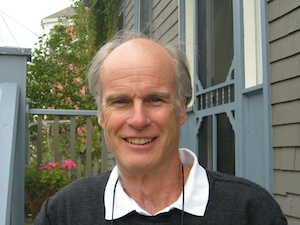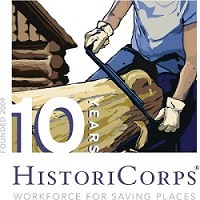 January 2021 marks a transition in leadership for an organization Colorado Preservation, Inc. is incredibly proud to play a part in forming. HistoriCorps’ first executive director and CEO, Towny Anderson, will retire, marking a new chapter in his and HistoriCorps’ future. HistoriCorps began as a program under Colorado Preservation, spinning off to become a stand-alone nonprofit in 2013. Towny joined HistoriCorps in 2011 as a consultant, bringing his unique background accumulated over a career spanning 48 years. He has been a restoration carpenter, preservation contractor, historic property re-developer, historic downtown revitalization consultant, and State Historic Preservation Officer. Towny moved to Steamboat Springs in 1999 to open the western regional office of the Vermont-based Orton Family Foundation, which seeks to strengthen the social, cultural, and economic vibrancy of communities through its now trademarked “Heart & Soul” program. Although he expected to be here for three years, historic preservation and back country powder skiing kept him enchanted with Colorado to this day.
January 2021 marks a transition in leadership for an organization Colorado Preservation, Inc. is incredibly proud to play a part in forming. HistoriCorps’ first executive director and CEO, Towny Anderson, will retire, marking a new chapter in his and HistoriCorps’ future. HistoriCorps began as a program under Colorado Preservation, spinning off to become a stand-alone nonprofit in 2013. Towny joined HistoriCorps in 2011 as a consultant, bringing his unique background accumulated over a career spanning 48 years. He has been a restoration carpenter, preservation contractor, historic property re-developer, historic downtown revitalization consultant, and State Historic Preservation Officer. Towny moved to Steamboat Springs in 1999 to open the western regional office of the Vermont-based Orton Family Foundation, which seeks to strengthen the social, cultural, and economic vibrancy of communities through its now trademarked “Heart & Soul” program. Although he expected to be here for three years, historic preservation and back country powder skiing kept him enchanted with Colorado to this day.
Colorado Preservation Executive Director Jennifer Orrigo Charles virtually “sat down” with Towny to discuss this vital organization and his decade-long impact.
Why is HistoriCorps a critical organization, and how does it help advance preservation in Colorado and beyond?
 HistoriCorps was founded to assist federal land management agencies (specifically USDA Forest Service) in addressing its obligation to preserve its thousands of historic resources that deteriorated over decades of deferred maintenance and repair. Federal land management agencies were experiencing budget and staffing cuts. It was clear that they were going to rely more and more on volunteers. HistoriCorps is the first preservation organization to programmatically engage volunteers in rehabilitating historic buildings and structures on public lands with a hands-on, experiential learning approach. We specialize in small budget maintenance and repair – historic preservation at its root – mostly remote single-story structures. Combine this with an outdoor adventure experience. We have struck a chord with thousands of volunteers, students, and conservation corps. We are reaching people who may never have thought of themselves as preservationists.
HistoriCorps was founded to assist federal land management agencies (specifically USDA Forest Service) in addressing its obligation to preserve its thousands of historic resources that deteriorated over decades of deferred maintenance and repair. Federal land management agencies were experiencing budget and staffing cuts. It was clear that they were going to rely more and more on volunteers. HistoriCorps is the first preservation organization to programmatically engage volunteers in rehabilitating historic buildings and structures on public lands with a hands-on, experiential learning approach. We specialize in small budget maintenance and repair – historic preservation at its root – mostly remote single-story structures. Combine this with an outdoor adventure experience. We have struck a chord with thousands of volunteers, students, and conservation corps. We are reaching people who may never have thought of themselves as preservationists.
What first drew you to the organization, and how has your experience shaped HistoriCorp’s early forming?
I will never forget, in the mid-’80s, having a conversation with my attorney about my company, HouseJoiner, Ltd., and reorganizing it as a nonprofit preservation school. He thought I was nuts and dissuaded me. The theme that runs through my preservation career is a passion for historic preservation’s hard skills and field practice. I admire and respect the skilled carpenters, masons, and tradespeople who do the work. I was drawn to HistoriCorps because it created the perfect vehicle to fulfill my passions and give back to the preservation community, knowing this would probably be my last job before retirement. At the time, some advisory committee members saw HistoriCorps’ growth to be in the role of “broker,” bringing together the fundamental components for preservation projects: property/ building owner, funding source, project management, and preservation expertise and workforce. I had a conversation with one of the founders, Terri Liestman from the Forest Service, and she made it crystal clear that the USFS would have no use for that service. They needed “boots on the ground, step on – step off” service, a partner who could execute. We have never looked back.
What has been your vision for HistoriCorps, and what elements of its success are you most proud?
We envisioned HistoriCorps as a unique and effective gateway for introducing people to the principles and practice of historic preservation, inclusive and accessible regardless of experience or skill. All that matters is a good attitude and willingness to learn. A measure of our success is folks leaving a HistoriCorps project with not only a sense of accomplishment but a newfound preservation ethic. I wanted to build HistoriCorps into an organization that offered career opportunities for the up-and-coming generations of preservationists. I also wanted HistoriCorps to become the provider of hands-on preservation education for students across the country. Hands-on instruction is well known to be life-transforming for many participants. After a few faltering starts, I believe we have everything to achieve that goal in the next 24–36 months, including a strategic plan and new board members aligned with this vision. What I am most proud of is the relationships that we have built over the years. We have returned to multiple forests two and three times – one forest nine years running now. We have diversified our partnerships to include other federal land management agencies, state parks, counties and municipalities, and nonprofit stewards of historic properties.
Do you have a story from the field that you would like to share?
In September 2015, I drove up to Dubois WY to do a conditions assessment for Simpson Lake Lodge in the Fitzpatrick Wilderness of the Shoshone National Forest. Our local contacts were the former manager and the CM Ranch owner. Their founder built the lodge and guided fishing expeditions to Simpson Lake in the ’30s and ’40s, one of the most spectacular places I have ever seen. The manager knew my brother, who owned the Paradise Ranch outside of Buffalo, WY, so I guess she assumed I learned how to ride a horse. I didn’t, but once they found that out, these two expert horsewomen were gracious and patient on the four-hour ride in and back out the next day, though they had more than a few laughs at my struggles to stay in the saddle. I ended up walking the horse for the last mile out, and it was all I could do to walk over the next two days.
What advice do you have for Colorado preservationists? How do we as a field remain relevant in 2020 and beyond?
Oh my. I have been involved in historic preservation as a craftsman, contractor, developer, bureaucrat, and policymaker. I have engaged in battles over decisions to preserve or demolish historic buildings from both sides of the table. One of the most influential voices in preservation for me has been Donovan Rypkema, who I first met in 1994. He was the first person to quantify the economics of historic preservation and has been tirelessly writing about and lecturing and consulting on the subject to this day. To continue to be relevant, we have to demonstrate the economic value of saving old buildings, again, and again, and again! This is the most effective and necessary path to “mainstream” historic preservation. You may ask, where does HistoriCorps fit into this equation? Much of the work that we do with the Forest Service rehabs fire lookouts, ranger stations, and many structures from the CCC era is repurposed for the recreation.gov cabin rental program. The Forest Service did a study and found that historic cabins consistently had the highest occupancy. These days, and in the future, we also have to demonstrate the social and environmental value of preserving these resources.
What would you like to see from the organization and the preservation community moving forward?
What I want to see is for all of us, from practitioners to advocates to grantors to educators, to open our arms and transform a historically exclusive club into an inclusive community. It is beginning to happen. I am proud to say one of six core values written into HIstoriCorps’ recently approved Strategic Plan is “Community: Accessibility, Inclusion, and Diversity.”
Anything we did not cover that you would like to share?
I don’t think I have ever engaged in a discussion about, or reflected upon, historic preservation without quoting the great economist, John Kenneth Galbraith. He noted in 1980, “The preservation movement has one great curiosity. There is never retrospective controversy or regret. Preservationists are the only people in the world who are invariably confirmed in their wisdom after the fact.” Juxtapose Galbraith’s observation with Joni Mitchell’s lament for the ages, immortalized in song,
Don’t it always seem to go
That you don’t know what you’ve got ’til it’s gone?
Preservationists do know! Before it’s gone! Our Sisyphean task is to help our communities, our world, to know, too.
Thank you, Towny and HistoriCorps, for leaping forward – we celebrate with you the 10th Anniversary of the program!



